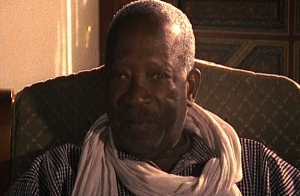 Christine Delorme is a French filmmaker, and producer for public radio station, France Culture. She first met influential African filmmaker Ousmane Sembène at 1985’s FESPACO. In 1992, while shooting his film Guelwaar — a comedy about the conflict between Senegal’s Muslim and Christian communities — Sembène sat down for a filmed interview with Delorme. Shot in a Paris mosque, Delorme edited and released the interview as a 52-minute documentary, Ousmane Sembène Tout A La Fois [All at Once]. The film is a rare instance when Sembène, who never acted in films, allowed himself to be recorded for an extended period. In April of 2013, Delorme visited New York City to screen her film, along with Sembène’s landmark 1963 18-minute film debut Borom Sarret, at the 20th New York African Film Festival. After the screening, she took questions from the audience, and sat down with Camera In The Sun to discuss the cinematic work of Sembène for a June 2013 interview.
Christine Delorme is a French filmmaker, and producer for public radio station, France Culture. She first met influential African filmmaker Ousmane Sembène at 1985’s FESPACO. In 1992, while shooting his film Guelwaar — a comedy about the conflict between Senegal’s Muslim and Christian communities — Sembène sat down for a filmed interview with Delorme. Shot in a Paris mosque, Delorme edited and released the interview as a 52-minute documentary, Ousmane Sembène Tout A La Fois [All at Once]. The film is a rare instance when Sembène, who never acted in films, allowed himself to be recorded for an extended period. In April of 2013, Delorme visited New York City to screen her film, along with Sembène’s landmark 1963 18-minute film debut Borom Sarret, at the 20th New York African Film Festival. After the screening, she took questions from the audience, and sat down with Camera In The Sun to discuss the cinematic work of Sembène for a June 2013 interview.
How did you come to work with Sembene following 1985’s FESPACO?
I told him the first time we met, “If you need someone to work with you in Paris, I can be that person.” I just offered that as sort of a crazy idea. But as soon as I got back to Paris, there was a letter awaiting me saying, “Could you find me a staff, producer, costumes and a set? We’re going to start.” And the project was to shoot a six-hour epic film on this African hero that has the same influence as Napoleon for French people: Almamy Samory Touré.
Sembène would be absolutely furious with the analogy to Napoleon. But I used that analogy to make people realize the historical importance of that character. But Sembène himself would never have made that comparison. Touré’s project was to unify all of Africa, and he resisted against the entire colonial penetration. Sembène wrote the scenario — three embedded scenarios — but the movie was never shot. The script was like three phone directories piled together.
How difficult was it to conduct a long-form interview with Sembène?
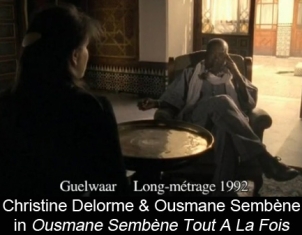 Given the personality and the character of Sembene, you can easily feel belittled by him just by his presence. Even today, and it’s been a while since I’ve seen him, just seeing the film and the images, I am so impressed by his presence and his vision — both of his history, but also of the history of France and the West. It is still strong, even on camera.
Given the personality and the character of Sembene, you can easily feel belittled by him just by his presence. Even today, and it’s been a while since I’ve seen him, just seeing the film and the images, I am so impressed by his presence and his vision — both of his history, but also of the history of France and the West. It is still strong, even on camera.
I really appreciated that the audience laughed during the movie, because Sembène was someone who was very funny. He could also be terrible, but he had a very strong sense of humor.
I recently learned that this is the longest interview he gave, and that it’s most likely that he was thinking about posterity. But I wasn’t. The documentary was done when he came to Paris to make Guelwaar, and we did talk about the other movies too. But at that time, he hadn’t yet shot Moolaadé or Faat Kiné. On Camp de Thiaroye, I was on the set, and I did shoot a making-of. But it has never been produced. So I have all kinds of rushes, which are very interesting, but have not been shown. It was an international set with a partly-Algerian crew, with an American actor, French actors, and actors from all over Africa, and the film was edited in Tunisia. And for Sembène, it was the idea of making a film that would gather all of Africa in the making of the film.
When Camp de Thiaroye was shot in Senegal, Sembène had to entirely remake the military camp. The French authorities boycotted it. The worst was that in the movie theater, the French critics were very aggressive against Sembène. But in Italy, at the Venice Film Festival, he won [the Special Jury Prize]. And now this film is at the origin of an entire series of other films made about the so-called Senegalese Tirailleurs, who were African soldiers from various countries, part of the French troops.
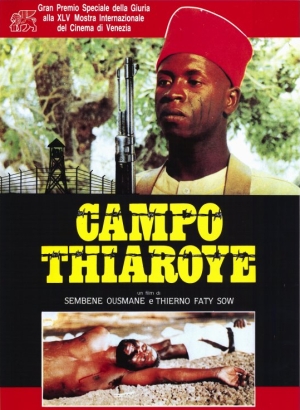 In 1944, at the end of World War II, these Senegalese Tirailleurs were fighting with the French Army against Germany. Then they were sent back to the various African countries they came from at the end of the war. But the French Army, before their return, gathered them all together. The French Army owed them pay for their time in the army, but gave only half of what it owed. And so the soldiers took hostage one of the officers, and a good number of them were shot without a court-martial. So, there was no trial. They were just summarily executed for insurrection or insubordination. Because Sembène spoke pigeon French, and he loves language, he played with that a lot in the way these soldiers talk — playing with that specific way of talking. The relation that he has to language is really fascinating, because he has a very strong love for words and for speech. But there is also violence in the way he uses the language.
In 1944, at the end of World War II, these Senegalese Tirailleurs were fighting with the French Army against Germany. Then they were sent back to the various African countries they came from at the end of the war. But the French Army, before their return, gathered them all together. The French Army owed them pay for their time in the army, but gave only half of what it owed. And so the soldiers took hostage one of the officers, and a good number of them were shot without a court-martial. So, there was no trial. They were just summarily executed for insurrection or insubordination. Because Sembène spoke pigeon French, and he loves language, he played with that a lot in the way these soldiers talk — playing with that specific way of talking. The relation that he has to language is really fascinating, because he has a very strong love for words and for speech. But there is also violence in the way he uses the language.
[Films about Senegalese Tirailleurs] forced the French government to finally recognize the contribution of these African soldiers in the French liberation in World War II. So in each of Sembène’s movies, there is something there that is ahead of the political events that would happen later. In Guelwaar, he deals with the question of international aid, which was ahead of the debate that was yet to come on that topic.
We had regular correspondence, because we were working together. So the letter [featured in Tout A La Fois] was about Guelwaar. He thought Guelwaar would be a political bomb, because it’s critical of international aid. The political bomb was in fact not where Sembène thought it would be. In Senegal it was a film that was mostly liked, because Sembène started with a real fact, but they thought that he made it up. There is a dead body that disappeared, and there was a conflict between the Muslim community and the Catholic community over that missing body. And after Guelwaar, many other such things happened. And people in Senegal thought that it was because of the movie that these things were happening.
What’s your take on how Sembène depicts the dynamic between men and women in his films?
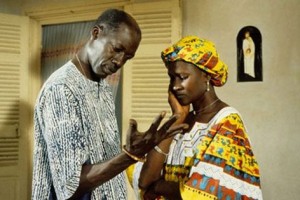 I’ve been thinking today about something I never thought of before. In Guelwaar, [Pierre Henri Thioune] gets killed because he refuses to beg and he refuses international aid. He’s a proud man, and also a domineering man in his family. But what is interesting is that it is a woman, his daughter, who in a way pays the price for his pride — but also carries it — because she becomes a prostitute. And if you see Guelwaar, she has a conversation with a priest where she explains that she had to become a prostitute to pay for the education of her brothers and sisters. And in Borom Sarret, the man transgresses the law and goes from the native district of town to the colonial district of town, and loses all of his money and his means of existence, which is his cart. When he gets back home, his wife hands him the baby over and says, “I’m going to find something to eat.” And what it really means, because it’s the evening — because the husband says, “At this time of day?” — is that she is going to prostitute herself.
I’ve been thinking today about something I never thought of before. In Guelwaar, [Pierre Henri Thioune] gets killed because he refuses to beg and he refuses international aid. He’s a proud man, and also a domineering man in his family. But what is interesting is that it is a woman, his daughter, who in a way pays the price for his pride — but also carries it — because she becomes a prostitute. And if you see Guelwaar, she has a conversation with a priest where she explains that she had to become a prostitute to pay for the education of her brothers and sisters. And in Borom Sarret, the man transgresses the law and goes from the native district of town to the colonial district of town, and loses all of his money and his means of existence, which is his cart. When he gets back home, his wife hands him the baby over and says, “I’m going to find something to eat.” And what it really means, because it’s the evening — because the husband says, “At this time of day?” — is that she is going to prostitute herself.
As a creator, Sembène’s very close to the sensibility of women. When he talks about polygamy, it might sound very realistic — that it’s not something that could be solved soon, that it runs very deep in society, and that he himself is part of that culture — even if in the end, in all his movies he talks about one thing, which is the liberation of women.
How did you first hear about Sembène the author?
I think I was in the Netherlands, and working for Radio Netherlands at that time, which was broadcast in African countries. And I started, while in the Netherlands, to read Sembene’s books. And then I met the French publisher who participated in the creation of Présence Africaine.
 In France at that time, there was a group of people called the Africanists — anthropologists and ethnologists — who knew Sembène. Among them was Jean Rouch, the filmmaker. It was very controversial. For Sembène, being recognized by anthropoligists was a problem for him. Because official literature in France recognized people like [Léopold Sédar] Senghor, rather than him. As Sembène came from the French Communist Party, all the radical intellectual Left in France were interested in his work because they were coming from the Left. But they were much more interested in the movies, than in the books. For example, talking about Sembène’s books was always with Africans. But back then, it was rare to be able to have a conversation with French people about the books, or to find people who had really read the books. Today it’s possible. It happens. But back then, it was not the case. And now there are conferences on Sembène in France.
In France at that time, there was a group of people called the Africanists — anthropologists and ethnologists — who knew Sembène. Among them was Jean Rouch, the filmmaker. It was very controversial. For Sembène, being recognized by anthropoligists was a problem for him. Because official literature in France recognized people like [Léopold Sédar] Senghor, rather than him. As Sembène came from the French Communist Party, all the radical intellectual Left in France were interested in his work because they were coming from the Left. But they were much more interested in the movies, than in the books. For example, talking about Sembène’s books was always with Africans. But back then, it was rare to be able to have a conversation with French people about the books, or to find people who had really read the books. Today it’s possible. It happens. But back then, it was not the case. And now there are conferences on Sembène in France.
His first novel was Le Docker Noir. It’s the life of a longshoreman in Marseille in France. Some of the books are inspired by real events — facts that appeared in the newspapers, for example — and then he would build a story around that. Others are based on experiences that dealt with the construction of railroads in Senegal. Then there is the one about the life of this Black longshoreman in Marseille.
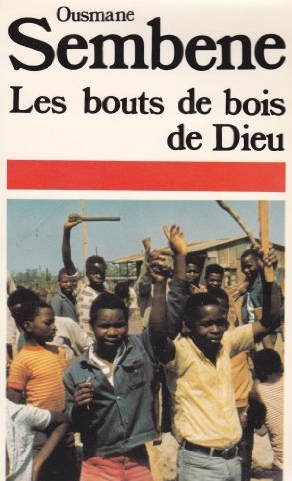 In his own personal life he was a longshoreman, a mason, worked construction — he did many odd jobs — and he was also one of these African soldiers enrolled in the French Army in World War II. And he’s a keen observer, as maybe you’ve noticed in the movie Borom Sarret. When you see the medal on the ground, it’s a military medal. And the policeman steps and crushes the military medal. It’s the worst thing he could do to that man. It’s worse than taking away his cart.
In his own personal life he was a longshoreman, a mason, worked construction — he did many odd jobs — and he was also one of these African soldiers enrolled in the French Army in World War II. And he’s a keen observer, as maybe you’ve noticed in the movie Borom Sarret. When you see the medal on the ground, it’s a military medal. And the policeman steps and crushes the military medal. It’s the worst thing he could do to that man. It’s worse than taking away his cart.
Sembène’s father was a fisherman. So [in his work], there is always the history of the self-taught person that is very different than if you compare him with someone like Senghor — who went to the best schools in France, the most elite schools in the French system. And Sembène always had a very political vision of the position of each character in society
When he wrote a story, the scenario, when he created characters, he would talk to himself like an actor while he was writing. He would talk like the various characters. Each character in his films, he was very close to them, each and every one of the characters.
What was his approach to financing his films?
Sembène always struggled. He always worked the day, and often the night. Because if it is difficult to shoot an independent film in Europe and the U.S., in Africa it’s 100 times more difficult to shoot an independent film.
He was politically very tough with the production and distribution of his movies. He was very sharp in business, and no one could force him to do things he did not want to. Absolutely not. There were many things that he would not move that were important to him, and he would not go the other way.
He had worked with a French producer who was very famous in France — a man of the Left who thought of himself as very advanced and progressive, because he was co-producing Sembène. But when Sembène heard that the co-producer had sold the film, but did not tell him right away, it was terrible, and the producer went through a difficult moment.